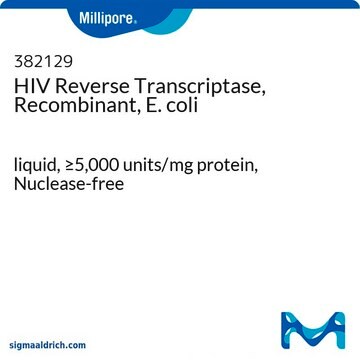ERT-RO
Roche
Expand™ Reverse Transcriptase
solution, recombinant, expressed in E. coli (AP401 (k)), sufficient for 20 reactions, sufficient for 100 reactions
Sinónimos:
reverse transcriptase, expand
About This Item
Productos recomendados
recombinant
expressed in E. coli (AP401 (k))
form
solution
usage
sufficient for 100 reactions
sufficient for 20 reactions
packaging
pkg of 1,000 U (11785826001 [20 μl])
pkg of 5,000 U (11785834001 [100 μl])
manufacturer/tradename
Roche
parameter
42-43 °C optimum reaction temp.
technique(s)
RT-PCR: suitable
RT-qPCR: suitable
input
purified RNA
detection method
probe-based
storage temp.
−20°C
General description
Specificity
Reverse Transcriptase enzyme for RT-PCR reactions up to 3 kb
Application
Features and Benefits
- Obtain higher amounts of full-length cDNA transcripts and longer transcripts up to 13.5kb
- No RNase H activity
- Efficiently transcribes total RNA, mRNA, viral RNA and RNA rich in secondary structures
- Ideal for two-Step RT-PCR assay
- Purification of cDNA before PCR reaction is not necessary
Packaging
Unit Definition
Volume Activity: 50 U/μl
Other Notes
Legal Information
Solo componentes del kit
- Expand Reverse Transcriptase 50 U/μl
- Expand Reverse Transcriptase Buffer 5x concentrated
- DTT Stock Solution 100 mM
signalword
Warning
hcodes
Hazard Classifications
Eye Irrit. 2
Storage Class
12 - Non Combustible Liquids
wgk_germany
WGK 1
flash_point_c
does not flash
Certificados de análisis (COA)
Busque Certificados de análisis (COA) introduciendo el número de lote del producto. Los números de lote se encuentran en la etiqueta del producto después de las palabras «Lot» o «Batch»
¿Ya tiene este producto?
Encuentre la documentación para los productos que ha comprado recientemente en la Biblioteca de documentos.
Los clientes también vieron
Contenido relacionado
RT-qPCR detects specific targets with applications in gene expression and pathogen detection.
Nuestro equipo de científicos tiene experiencia en todas las áreas de investigación: Ciencias de la vida, Ciencia de los materiales, Síntesis química, Cromatografía, Analítica y muchas otras.
Póngase en contacto con el Servicio técnico














